Day 2 of the 21st International Conference on Condensed Matter Nuclear Science ICCF21 at the Colorado State University began early and sadly, yours truly was on sub-standard , and I missed several of the talks, including the first one, which I was really excited about.
Fran Tanzella presented Nanosecond Pulse Stimulation in the Ni-H2 System at 8AM. Unfortunately, I was late, and Tanzella was already in full-swing. He was showing a diagram of the 4th generation Brillouin Hot Tube (Isoperibol) which operates in an H2 gas, runs at a constant pressure and uses two types of calorimetry. The action begins with an automated sequence of low voltage pulses. The temperature is also varied from 200-600 degrees C in fixed intervals.
Sadly, I forgot my glasses, and could hardly see the screen of data. I had to leave and run to get them in the dorm room, quite a distance away.
Upon returning with full sight, Mitchell Swartz was already speaking on Aqueous and Nanostructured CF/LANR Systems. His quasi 1-dimensional model begins with the flow of deuterons in the lattice, but the take-away is that if you see bubbling in an aqueous systems, you will not succeed.
He then showed a graph of an improved system called Phusor. The light-water system which uses a gold anode and nickel cathode are ohmic controlled and at ICCF10 at Massachusetts Institute of Technology MIT, it demonstrated a 2.5x energy output live over three days.
Swartz has controlled “heat after death” and gotten massive excess heat. A JET CF Engine was the inspiration for DTRA to fund work in this space.
Swartz asked Melvin Miles for his voltage data (only electrical current was published) and when Swarz computed the energies using his model and Miles’ voltage numbers, agreement was made. Swartz said he has no doubt that what Miles discovered with the heat-helium correlation was correct.
There are two states in th pre-loaded nano-materials for the NANOR design, where energy gains at yet another live demo at MIT were 12x input power.
Swartz tries to characterize the material by starting at low-voltage and increasing the voltage until an “avalanche” episode downwards, which matches the Ohmic control. It is found that coherent optical beams interact with phonons to increase power in these systems.
Two states of the system, active and inactive, have been confirmed by spectroscopy, the excess heat, and another method. Mitchell Swartz works with Peter Hagelstein of MIT to understand the science through theory-driven experiments and they are continuing to collaborate on the NANOR design to achieve robust excess heat.
I had wanted to get a picture of Mitchell Swartz but he resisted as he had a black eye from bumping his head on the very square and hard wood bed frames in these dorm rooms! I’ll get that picture tomorrow.
Francesco Celani was next with Steps to Identification of Main Parameters for AHE Generation in Sub-Microscopic Materials Measurements by Isoperibolic and
Air-Flow Calorimetry
He first acknowledged Brian Josephson (among others) who wrote to the National Institute for Nuclear Physics INFN in Italy in support of the continuation of Celani’s research, despite the fact that he was at the working age limit and should be retired.
Celani’s work focused on Constantan materials. Since 2011 he uses gaseous Hydrogen with the thermocouple inserted within the Ni nano powders and not the Ni itself. Fe-Constantan is the best to work with at <700 C. To increase the surface are of of CNM wire, several hundred electric pulses (50ms duration) are applied. He showed a diagram of the cathode wires with "knots" in them. A video camera on the wire during activation showed the pulses actually flexing the wire wildly. The knot regions are significantly hotter than the regular straight wire, and, the chemical composition of the wire also changed. He found the active area of the wire is in the sub-micrometric surface. The anomalous heat generated is inversely proportional to the diameter of the wire. Putting glass sheaths around the wire also proved to increase the heat effect and in at least one case melted the glass.
M.R. Staker then spoke on Coupled Calorimetry and Resistivity Measurements, in Conjunction with an Emended and More Complete Phase Diagram of the Palladium- Isotopic Hydrogen System
He had a huge outline of material first focusing on H-induced Vacancy Formation.
SAV are the most stable structure of all M-H alloys, a “true equilibrium form”. The same thermal de-sorption occurs for nickel, copper and other materials.
Then, E.J. Beiting of spoke on Investigation of the Nickel-Hydrogen Anomalous Heat Effect reproduced from The Aerospace Corporation’s paper Investigation of the Nickel-Hydrogen Anomalous Heat Effect.
Get the report on the Aerospace Company’s Library page by referencing the number ATR-2017-01760.
Beiting spent 20 years investigating electric propulsion. Most satellites are launched with electric propulsion. Cold fusion /LENR will revolutionize this space, allowing more high-power communication and dropping the large, bulky and weighty solar power systems.
He noted that NASA has developed a Stirling engine with a 20-year lifetime.
Aerospace Corporation IRAD Limitation Resources are scarce in the skeptical environment there, and Beiting had one experimental shot to try an investigation.
He chose to replicate the Arata/Ahern Sample Preparation, using thermal triggering and a DC power supply.
Sample preparation was similar to that in yesterdays Technova presentation. Nanometer Ni-Pd particles are added in micron-sized particles. He deviated from Arata/Ahern by adding small magnetic materials.
Two experiments used two cells each, an active and a control cell. Details are in the Aerospace report, but Beiting saw excess heat in both cells, and more excess heat with the magnetic particles. He recorded power in, pressure, and temperature. X-ray tomography (excellent equimant at Aerospace Corp.) on the cell revealed the internal structure of the loaded cell, and how the material was situated.
20 grams of active material were in each cell and the active cell received about 20 grams of magnetic materials.
The gas-loading period was 2 days, the heating-triggering period was 4 days. Total run time of the experiment was 10 weeks.
At 950 hours (40 days), excess energy appeared to be greater than chemically possible with a 7.5% excess power. He feels confident that he has verified results of Arata/Ahern.
A few weaknesses were that thermometry was used instead of calorimatry, and the thermocouples were imbedded in the sample which had caused a possible reaction with the sample and a possible hot spot.
Upper management of Aerospace Corporation were at Univeristy of Utah during the early years of this science, and continue to be skeptical. He noted that very competent physicists give non-scientific objection without even looking at the data.
After researching the psychology of this, Beiting ended with CONFIRMATION BIAS + COGNITIVE DISSONANCE do not equal CRITICAL THINKING.
A short break allowed me to take some photos of the crowd before William Collis of ISCMNS introduced Jean-Paul Biberian to speak on Anomalous Isotopic Composition of Silver in a Palladium Electrode for the session on Transmutations.
Biberian worked with a cathode given to him by Stanley Pons in 2001 from the ICARUS 9 cell. He aimed to do SIMS analysis to detect any transmutations. He showed a diagram of the double-walled cell and listed various fusion reactions involving PD+D that give silver Ag isotopes.
The cathode was a 100mm x 2mm pure palladium rod and Biberian heated it at 600 degrees C to be sure there was no deuterium left in the cathode.
Always separate experimental data from interpretation, Biberian was told by the Director of his lab years ago.
Ag107 was found 1 micron below the surface, which he says might be the region of active zone, but there was only a 3/100 increase of Ag 107 / Ag-109 which he found rather disappointing.
Biberian’s results are in agreement with John Dash’s work, and he concludes that Ag107 is produced, or formation of Pd-107 with a long half life is produced. Also, Biberian states that the reaction is a surface reaction one micrometer thick and happens only in hot spots.
Max Fomatchev-Zamilov presented Synthesis of Lanthanides on Nickel Anode and began by saying he would like to see a set of instructions for a reaction, and this is the inspiration for his work. He decided to reproduce an earlier experiment design from 1953 that would focus on neutrons, using an x-ray tube within a a housing of lead bricks and neutron counters on each side.
Counts using a nickel and titanium anode were statistically significant at better than 5% level and repeatable. But then he looked for systematic errors and after removing them, his statistical significance was removed too.
Sternglass was in error on this: neutrons were not synthesized, and lanthanides were not synthesized. However, Fomatchev says the experience allowed him to develop experience in SEM, EDS, precision neturon/gamma detection techniqes and he is ready to help you do analyses with his full lab equipment.
G. Lu and W Zhang were unable to attend, so the next speaker was Vladimir Vysottski, who filled in with a talk on biological transmutations, beginning with a nod to C.L. Kervan’s work on biological transmutation, which Vysottski does not want to separate from the general transmutation reactions with isotopes.
In their early research, Vysottski and Kornilova discovered that Mn55 + D2 = Fe57 + 15.6MeV.
A biological culture grows in D20 in 48 hours and a Mossbauer analysis is done. It is found that 10 ^-8 Fe57 are generated per second. 10 micrograms of Iron are created for 1 gram of dried biological culture.
Investigating a great number of different cultures, they get the same results.
The expectation that Cs133 + p = Ba134 was a later investigation. Sure enough, Cs decreased over time, and the Ba increased by 10^-6 per second.
Vysottski de-activated radioactive nuclear reactor water and saw a decrease in gamma activity over a period of 45 days, the duration of the experiment, and the increase of Ba138, indicating the decreasing presence of Cs137.
The next speaker A. Nkitin followed up on that theme with Impact of Effective Microorganisms on the Activity of 137 Cs in Soil from the Exclusion Zone of Chernobyl NPP.
Effective Microorganism (EM) has been globaly used for sustainable agriculture, animal husbandry and environmental conservation for 25 years. There are two forms of EM, liquid and solid.
In one experiment, Cs137 activity was decreased in the soil of a corn field treated with EM-1. In another experiment, soil in a column was treated repeated with EM causing a leaching and decrease of Cs137.
Then they investigated the effect of EM on the rate of radioactivity of Cs137. Contaminated soils were placed in 100-ml containers and mixed with EM1 or EM-bokashi and kept at room temperature. Periods of exposure were 6, 12, and 18 months with experiments repeated 15 times.
Varying levels of decrease in Cs137 activity were observed according to the parameters. Also, electromagnetic fields can accelerate this process.
After lunch, Yasuhiro Iwamura introduced Sveinn Olafsson of University of Iceland with What is Rydberg Matter and Ultra-Dense Hydrogen?Scientists Leif Holmlid was working with ultra dense Hydrogen 2.3 +/- 0.1 pm and Olafsson wanted to work with him.
Tunneling fusion rate is given by the Gomov probability of crossing the barrier times the attempt frequency. 0.2 eV bonding per state possible if d ~ 2.3 pm
Is Rydberg matter a frozen plasma state?
A laser is directed towards a cluster of dense hydrogen and the time of flight of the ejected particles (the time it takes to go a particular distance along a tube to a detector) measures how the cluster falls apart, which will be a function of the distance between atoms, too. A bond distance of 2.3 pm is found.
Olafsson has a nice Rydberg lab in Iceland with three different Rydberg matter cells. He will continue to work in this space with Holmlid and the next speaker, a PhD student at University of Iceland.
Sindre Zeiner-Gundersen spoke on Hydrogen Reactor for Rydberg Matter and Ultra Dense Hydrogen, a Replication of Leif Holmlid. Zeiner experimentally confirmed Holmlid with a tight replication, though it took 3 years!
Time of Flight was 180 micro seconds, too slow for Rydberg matter. Finally, he saw Rydberg matter at 20 microseconds.
He increased the length of the time of flight tube
With a length 236 cm, time of flight was 31 nanoseconds corresponding to 7.55 MeV. He then went down to time of flight of 14 nanoseconds and the ultra-dense deuterium signal was observed.
As I was dropping out of conscioussness due to lack of sleep, I had to exit and return to the dorm for a rest. I missed the last session of the day on Theory where Xing Zhong Li presented Resonant Surface Capture Model, J.-L. Paillet and A. Meulenberg presented On Highly Relativistic Deep Electrons, C. D. Stevenson and J. P. Davis spoke on Isotope Effects beyond the Electromagnetic Force: 1H and 2H in Palladium Exhibiting LENR, and V. Dubinko talked about Chemical and Nuclear Catalysis Mediated by the Energy Localization in Hydrogenated Crystals and Quasicrystals.
I made it back for the International Society of Condensed Matter Nuclear Science annual meeting where a new website was discussed, as well as changes in the organizational structure.
Ironically, two Cooks, Bob Cook and Norman Cook, are both leading special theory sessions Tuesday nite (right now!) and tomorrow Wednesday night. I had to skip the session tonite but I am about to hit the hay and get a good night’s rest for tomorrow’s heavy science download.
I can’t say enough how thrilling it is to be amongst such driven researchers who are working at the edge of what is known. The atmosphere is charged with hope and commitment. Here are some snapshots I took during the morning break. Can you see the excitement on their faces?!

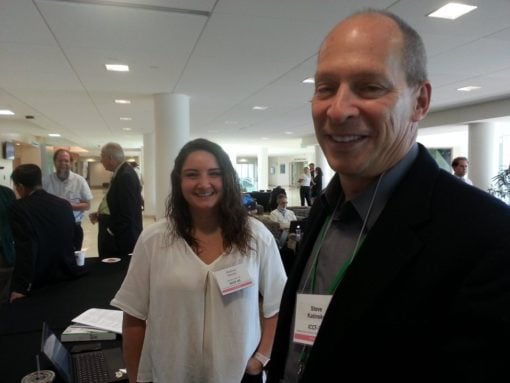
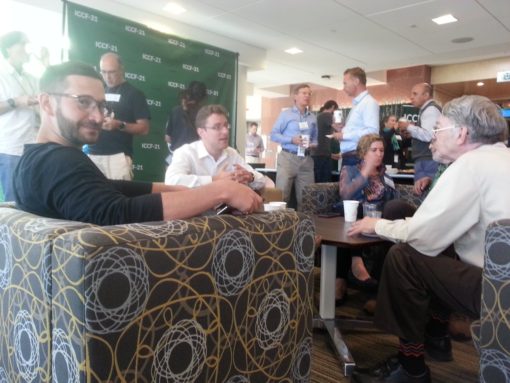
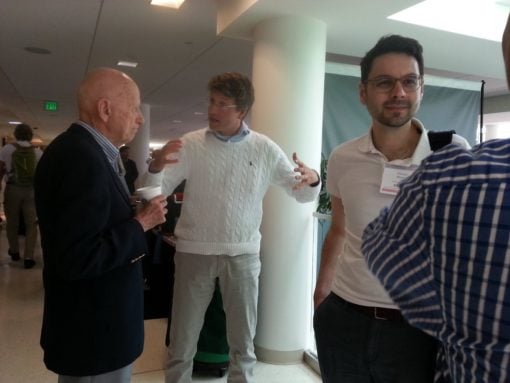
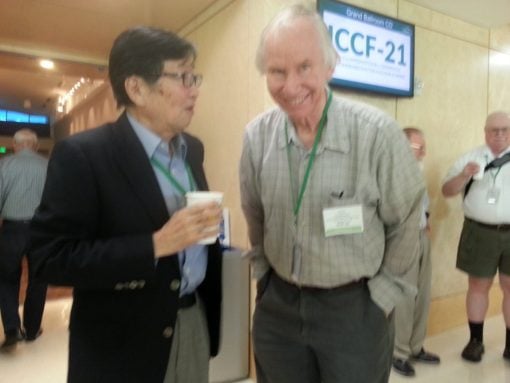
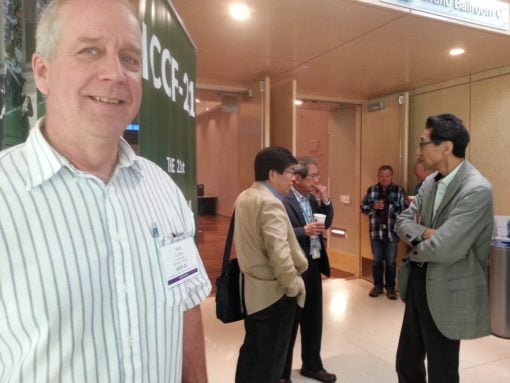




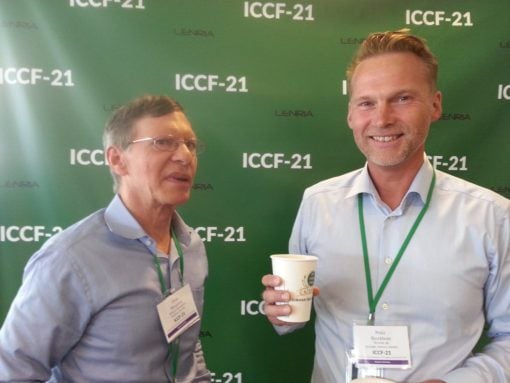


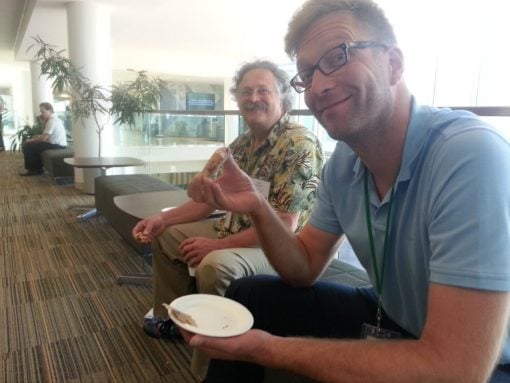
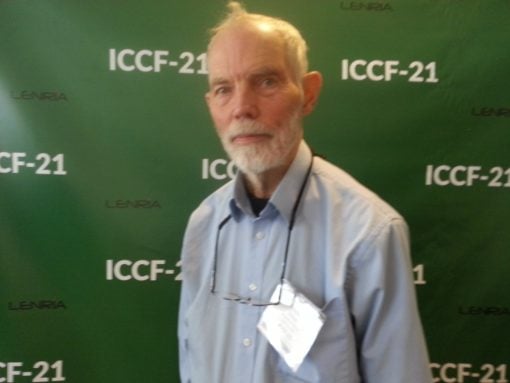
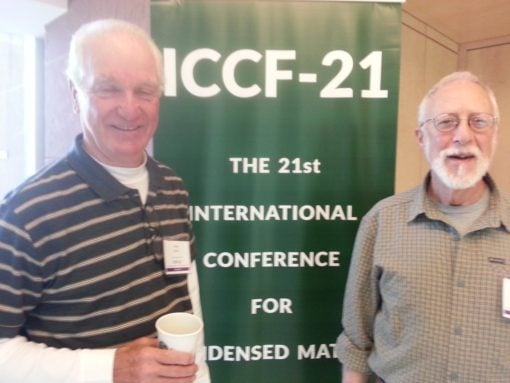
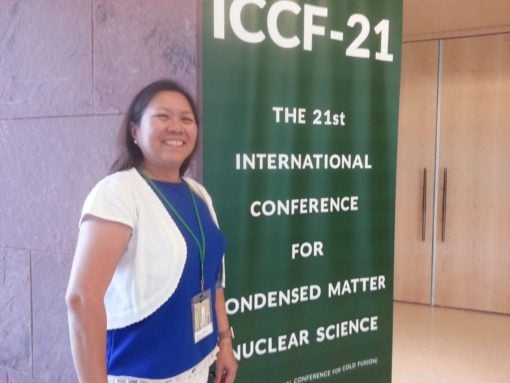
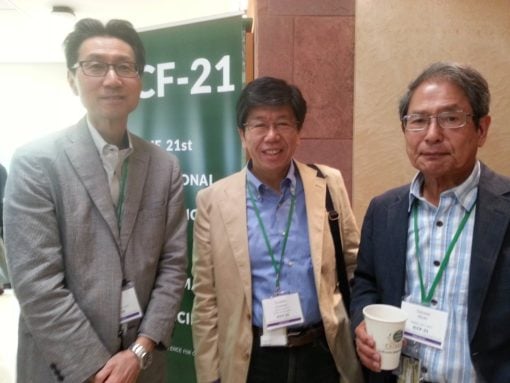



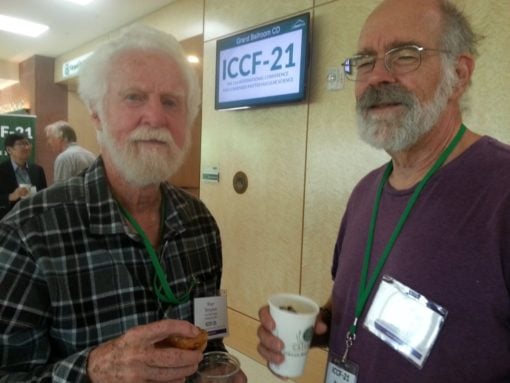
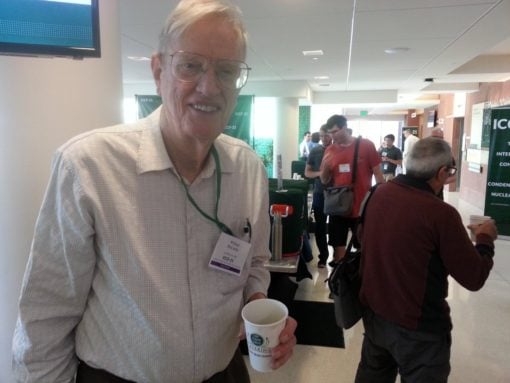
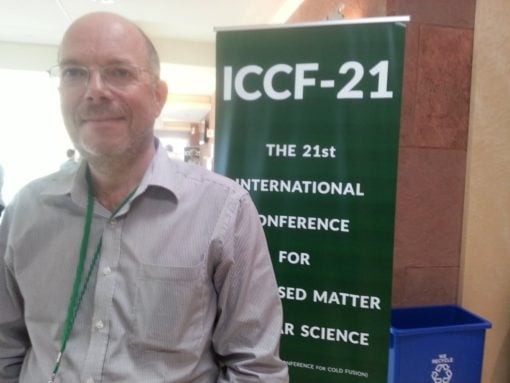
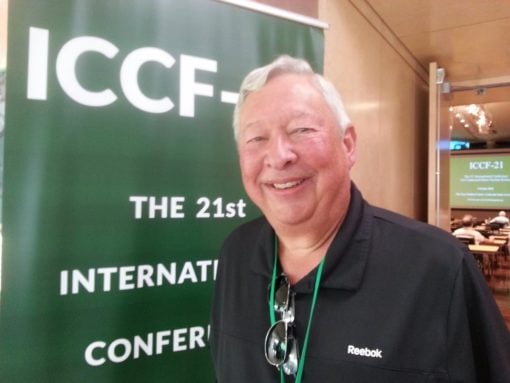

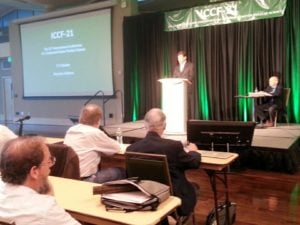




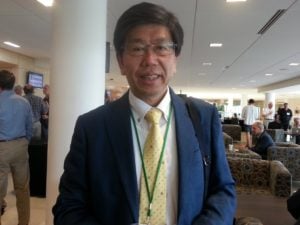
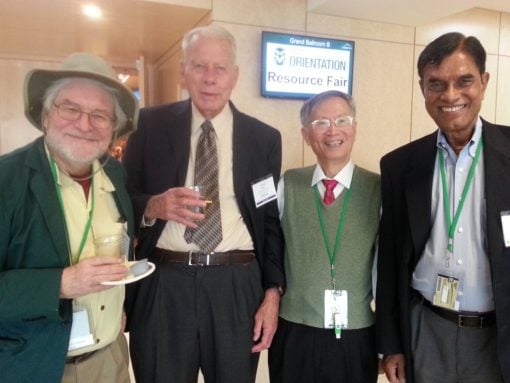
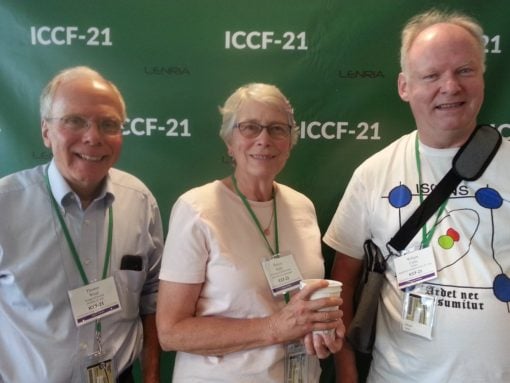

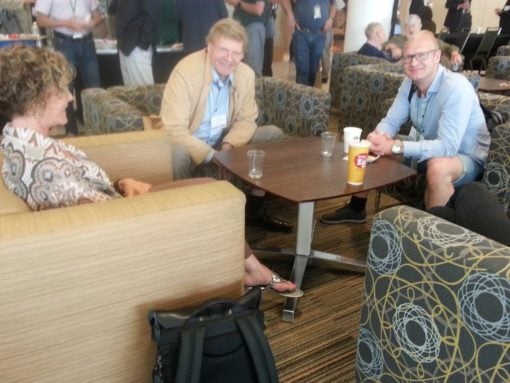


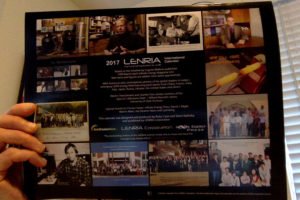
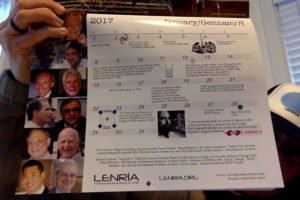
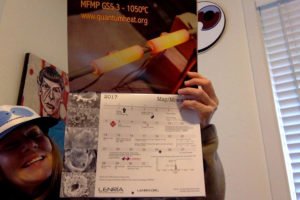

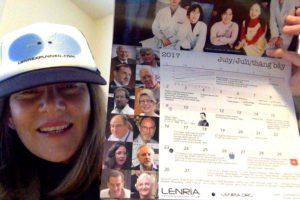
 Poster art by Tom Maguire
Poster art by Tom Maguire